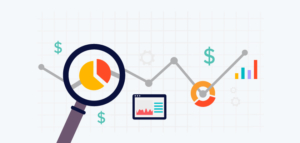Metrics vs. Analytics: Track the Right Data and Ask the Right Questions

Though the terms are often used interchangeably, metrics and analytics actually refer to two different things. One is a noun (i.e. a thing) and one is a verb (something you do with that thing). So when people don’t differentiate between the terms, conversations around data collection can get muddy.
Get clear on what a metric is, what it means to analyze those metrics and how to do it all effectively so you move those ever important needles.
What is the Difference Between Metrics and Analytics?
While both metrics and analytics refer to ways of interacting with collecting data, they don’t mean the same thing. In the simplest terms, metrics are the data you collect and analytics are the insights you draw from your data. We’ll dive into the specifics below.
Metrics
As we said above, your metrics are the data you collect. Anything that can be objectively measured in numeric form counts as a metric. Some examples of metrics include:
- Your total revenue for a timeframe
- Number of customers in a month
- Average amount spent per customer
- Number of visitors to your website
Your metrics are also used to define your KPIs and how you measure your business’s success. For example, your company could watch the customer acquisition cost metric and set a goal to reduce those costs to better fit your needs. Your KPI would measure how successful your initiatives have been at reducing your CAC.
Metrics differ based on industry and it’s crucial to know which ones work best for companies who have been successful in your industry.
Book a personalized demo with our team to learn how to drive revenue through analytics!
Analytics
Analytics is the process for analyzing your data. Analytics has nothing to do with actually gathering the data, it’s the second step where the data is given meaning. Then, based on your analysis you can make realistic goals and decisions.
Why Are Metrics and Analytics Important?
As noted, the sheer amount of data available means you need parameters to whittle down said data and decrease the amount of background noise in your information. Monitoring specific metrics can provide valuable information for your company, as long as you know what to look for.
Analytics are important for similar reasons. Setting your parameters for data collection is fine, but what you do with that data is vital. Analytics requires critical thinking to look for data trends and to understand why customers behave the way they do. It can be challenging to estimate what’s going on in people’s heads, but with the right analytics, you can make educated guesses about which features they prefer and what they want from your company or product in the future.
How You Should Track Your Metrics
There are many software tools available to track specific metrics. Some social media platforms, like Twitter, Facebook, and Instagram have built-in tools that allow you to measure your performance within the apps themselves. These native tools are effective and collect accurate data, but it is time-consuming to compile data from multiple websites and accounts.
Instead of gathering that data manually, you can enlist the help of Kissmetrics to automate the data gathering according to your parameters. This saves time, energy, and overhead costs by keeping all of your data from multiple sources in one place. You can then run the reports you need and make fact-based decisions for the company.
What Metrics Should You Track?
Choosing your metrics can be challenging with so many available. Some metrics, like total revenue for the year and operating expenses are particularly useful across the board. Others only apply in certain situations, like businesses with a subscription model, e-commerce or retail companies, or companies who must invest in long-term depreciable assets.
Upper Funnel Metrics
Upper funnel metrics like those found in the Kissmetrics Funnel Report measure how aware people are of your brand and how widespread your audience is. The majority of people who know about your brand may not become customers, but it is important to have as much exposure as possible. These metrics can include:
- Pageviews
- Pages per session
- Branded search
- Website traffic
- Bounce rate
- Targeted engagement
- Inbound links
- Brand awareness
Lower Funnel Metrics
The lower funnel metrics measure customer conversion and following up with leads. This is where your audience starts to not just become aware of your brand but become customers.
Usually, people aren’t ready to buy the first time they hear about you; they need some time to think over their purchases. These metrics can include:
- Sales qualified leads
- Revenue
- ROI
- Conversion rate
From these metrics, you can create KPIs to measure your progress like:
- Customer acquisition costs
- Quality of leads
- Customer retention
- Customer lifetime value
How to Analyze Your Metrics
Your metrics will bring in a wealth of data, but that data is meaningless if you don’t know how to analyze it. As an example, if you send out a survey asking your customers how likely they are to recommend your brand to friends and family, (known as the Net Promoter Score), you’ll receive data showing the percentage of people who would recommend you, who wouldn’t recommend you, and who feel neutral about your brand.
However, with critical thinking, you can pull out many more insights than percentages. You might look into which customers were more likely to recommend your brand. Who are they? What are their demographics? The Kissmetrics person profile will give you specific details about a customer.
Did their experiences differ significantly from people who had lower scores or was the score based around other preferences? Our path report demonstrates how a customer went through their user journey and might shed light on any significant differences.
Questions to Ask During Analysis
As you analyze the data gathered for your given timeframe, it’s important to keep a few questions in mind as you dive into the reports.
Have We Set Up Our Tracking Tools Correctly?
The only thing worse than making decisions based on no data is making decisions based on bad data. So make sure you check, then double-check your parameters, how your tools are working, and how reports are generated. If you see something in one of your reports that stands out as strange, it might be an issue with how you’ve set up your tracking tools.
If you think there is a problem, but don’t know how to resolve it, Kissmetrics provides resources for support. It’s annoying to find that you’ve wasted time by tracking data incorrectly, but it’s better to find out now and solve the problem.
Is the Qualitative Data Accurate?
Hopefully, the answer is yes. However, there are a variety of reasons why users may not respond accurately to surveys or deviate from expected journeys. Users may have had a bad day and answer negatively. Or, they may not remember precise answers for your survey.
To compensate for this, you should carefully consider the wording of your questions and how many questions a survey contains. Single-question surveys are often the easiest for busy people to complete. You should also ensure that your questions are simply worded and plainly ask for the information you want.
Do Other Systems Deliver Similar Results?
While we don’t recommend having multiple software systems all tracking the same metrics, we do think that there is merit in comparing metrics with ones natively tracked through social media platforms, for example, just to ensure that your software is providing similar results. Small deviations can occur because of differences in certain parameters like timeframe. For instance, your timeframe parameter in your analytics tool might be “last 7 days” and “last week” in the social platform. And if the social platform defines “last week” as in the previous traditional 7-day week, then the data you collect will probably look a little different.
But if your results differ wildly between systems, that could be a sign that you haven’t set up the metrics correctly or that you aren’t measuring the same data.
Are the Metrics You’re Tracking Important to Your Business?
While you may be able to receive some guidance about which metrics would provide essential information for your business, the best guidance you’ll get is from the experience of trial and error. Some metrics, like sales revenue, customer satisfaction, and total profit are common to all industries, but many metrics are more variable.
We recommend selecting some of the more common metrics of your industry, to begin with, and then give them some time to collect data. If you notice that they aren’t providing any value, there are plenty of other metrics for you to try.
What Decisions Can Metrics and Analytics Help You Make?
Metrics and analytics should be the basis for the majority of your business decisions. Fact-driven decisions are always more likely to be successful than random shots in the dark.
This extends to decisions about which features to build, how to prioritize bug fixes, which types of products you should produce in the future, allocation of resources and much more.
They can also guide your marketing team with insights and measurements about your user base. When it comes to attracting new customers, the insights gathered from your existing customers can give your marketing team ideas for everything from email campaigns to landing pages to social media campaigns.
In short, metrics and analytics allow your company to optimize its revenue and profit.
Conclusion
Collecting the right metrics is just as important as your follow-up critical analysis of that data. Company decisions about product development, services offered, and merchandise expansion should all be driven by fact-based insights into current market trends. Tracking the right data can give you an edge over your competitors and keep you in the game.
Book a demo call with our team at Kissmetrics to see how you could be leveraging your data.
Sources:
Data, Metrics, and Analytics: What’s the difference?
What are business metrics? Definition and Examples
Analyzing Marketing Data: Differentiate between Metrics and Insights



